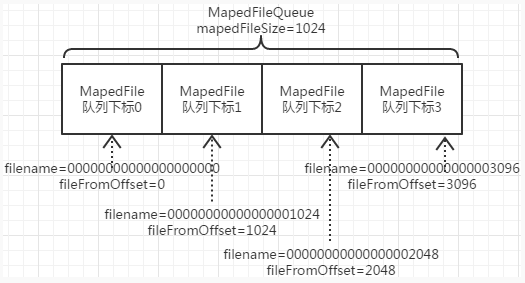RocketMQ的消息存储过程非常复杂, 本文先介绍存储模块中几个重要对象.
1. MappedFile
对MappedByteBuffer的封装, 具有创建文件(使用非堆区内存), 写入, 提交, 读取, 释放, 关闭等功能, RocketMQ使用该类实现数据从内存到磁盘的持久化.
关键字段
- fileChannel: 该类对应的文件通道.
- mappedByteBuffer: 文件在内存中的映射. 如前文所述RocketMQ使用内存映射的方式来操作文件, 这种方式要比流的方式快很多.
- fileSize: 文件尺寸
- wrotePosition: 当前写到哪一个位置.
- committedPosition: 已经提交(已经持久化到磁盘)的位置.
- flushedPosition: 已经提交(已经持久化到磁盘)的位置.
- writeBuffer: 内存字节缓冲区, RocketMQ提供两种数据落盘的方式: 一种是直接将数据写到映射文件字节缓冲区(mappedByteBuffer), 映射文件字节缓冲区(mappedByteBuffer)flush; 另一种是先写到writeBuffer, 再从内存字节缓冲区(write buffer)提交(commit)到文件通道(fileChannel), 然后文件通道(fileChannel)flush.
- fileFromOffset: fileFromOffset: 映射的起始偏移量, 拿commitlog文件来举例, 下面有很多个文件夹(假设为1KB, 默认是1G大小), 第一个文件名为00000000000000000000, 第二个文件名为00000000000000001024, 那么第一个文件的fileFromOffset就是0, 第二个文件的fileFromOffset就是1024
关键方法
- appendMessage: 插入消息到MappedFile, 并返回插入结果.
- selectMappedBuffer: 返回指定位置的内存映射, 用于读取数据.
(1) appendMessage
源代码如下:
public AppendMessageResult appendMessage(final MessageExtBrokerInner msg, final AppendMessageCallback cb) {
assert msg != null;
assert cb != null;
int currentPos = this.wrotePosition.get(); //获取当前写的位置
if (currentPos < this.fileSize) { //currentPos小于文件尺寸才能写入
//获取获取需要写入的字节缓冲区, 之所以会有writeBuffer != null的判断与使用的刷盘服务有关.
ByteBuffer byteBuffer = writeBuffer != null ? writeBuffer.slice() : this.mappedByteBuffer.slice();
byteBuffer.position(currentPos); //设置写入的postion
AppendMessageResult result =
cb.doAppend(this.getFileFromOffset(), byteBuffer, this.fileSize - currentPos, msg); //执行写入
this.wrotePosition.addAndGet(result.getWroteBytes()); //更新wrotePosition
this.storeTimestamp = result.getStoreTimestamp();
return result;
}
//返回错误信息
log.error("MappedFile.appendMessage return null, wrotePosition: " + currentPos + " fileSize: "
+ this.fileSize);
return new AppendMessageResult(AppendMessageStatus.UNKNOWN_ERROR);
}
可以看到MappedFile调用AppendMessageCallback来执行msg到字节缓冲区的写入.事实上整个RocketMQ只有一个类实现了AppendMessageCallback接口, 就是DefaultAppendMessageCallback. doAppend方法的具体实现与消息格式有关, 并且不属于MappedFile的范畴, 后文再分析.
(2) selectMappedBuffer
源代码如下:
//返回从pos到 pos + size的内存映射
public SelectMappedBufferResult selectMappedBuffer(int pos, int size) {
int readPosition = getReadPosition(); //获取当前有效数据的最大位置
if ((pos + size) <= readPosition) { //内存映射的最大位置必须小于readPosition
if (this.hold()) { //引用计数
ByteBuffer byteBuffer = this.mappedByteBuffer.slice(); // 复制一个byteBuffer(与原byteBuffer共享数据, 只是指针位置独立)
byteBuffer.position(pos); //设置position
//获取目标数据
ByteBuffer byteBufferNew = byteBuffer.slice();
byteBufferNew.limit(size);
return new SelectMappedBufferResult(this.fileFromOffset + pos, byteBufferNew, size, this);
} else {
log.warn("matched, but hold failed, request pos: " + pos + ", fileFromOffset: "
+ this.fileFromOffset);
}
} else {
log.warn("selectMappedBuffer request pos invalid, request pos: " + pos + ", size: " + size
+ ", fileFromOffset: " + this.fileFromOffset);
}
return null;
}
2. MappedFileQueue
顾名思义, 该类代表了MappedFile组成的队列(由大小相同的多个文件构成). 无论是CommitLog(消息主体以及元数据), 还是ConsumeQueue(逻辑队列), 底层使用的组件都是MappedFileQueue.
关键字段
- storePath: 文件队列的存储路径
- mappedFiles: 存储MappedFile的map
- mappedFileSize: MappedFile的尺寸
- flushedWhere: 已经刷到磁盘的位置
- committedWhere: 已经提交的位置
关键方法
- getLastMappedFile: 获取队列中最后一个MappedFile对象
- findMappedFileByOffset: 根据offset/filesize计算该offset所在那个文件中
(1) getLastMappedFile
源代码如下:
public MappedFile getLastMappedFile(final long startOffset, boolean needCreate) {
long createOffset = -1;
//获取当前Queue中最后一个MappedFile
MappedFile mappedFileLast = getLastMappedFile();
//一个文件都不存在时, 计算起始文件的offset
if (mappedFileLast == null) {
createOffset = startOffset - (startOffset % this.mappedFileSize);
}
//计算需要新创建的文件的offset
if (mappedFileLast != null && mappedFileLast.isFull()) {
createOffset = mappedFileLast.getFileFromOffset() + this.mappedFileSize;
}
//创建新的MappedFile
if (createOffset != -1 && needCreate) {
//计算文件名
String nextFilePath = this.storePath + File.separator + UtilAll.offset2FileName(createOffset);
String nextNextFilePath = this.storePath + File.separator
+ UtilAll.offset2FileName(createOffset + this.mappedFileSize);
MappedFile mappedFile = null;
if (this.allocateMappedFileService != null) {
//使用AllocateMappedFileService创建文件主要是更加安全一些, 会将一些并行的操作穿行化
mappedFile = this.allocateMappedFileService.putRequestAndReturnMappedFile(nextFilePath,
nextNextFilePath, this.mappedFileSize);
} else {
try {
mappedFile = new MappedFile(nextFilePath, this.mappedFileSize);
} catch (IOException e) {
log.error("create mappedFile exception", e);
}
}
//将新创建的文件添加到队列中
if (mappedFile != null) {
if (this.mappedFiles.isEmpty()) {
mappedFile.setFirstCreateInQueue(true);
}
this.mappedFiles.add(mappedFile);
}
return mappedFile;
}
return mappedFileLast;
}
从源码中可见, 只有当文件写满或者找不到文件时, 才会创建新的文件.
(2) findMappedFileByOffset
主要是根据offset寻找对应的MappedFile, 具体源代码不再贴出.
为了理解findMapedFileByOffset, 我们假设每个文件的大小是1024K, 参考以下图示:
如果现在想查找3021在那个文件中, 可以按如下计算:
(3021 - 0)/1024=2 即可知其在队列下标为2的MappedFile中
释义如下: (offset-第一个文件的fileFromeOffset)/mappedFileSize
3. CommitLog
用于存储消息的抽象封装, 内部采用MapedFileQueue实现了消息文件队列功能.
关键字段
- HashMap topicQueueTable: 用于记录某个topic在某个queueId共写入了多少个消息, put一个消息加1.
关键方法
- putMessage: 存储消息.
- getMessage: 读取消息
(1) putMessage
存储消息主要分3步: 查找文件(getLastMapedFile), 写入数据(DefaultAppendMessageCallback), 刷盘(FlushRealTimeService). 最终产生实际存储消息的队列文件如下:
${storePathRootDir}/commitlog/消息队列文件. (消息队列文件名规则如MappedFileQueue).
(2)getMessage(final long offset, final int size)
offset: 绝对偏移量, 可以用其调用findMappedFileByOffset查询MappedFile.
size: 欲查询的数据大小.
4. ConsumeQueue
消费队列的实现, 该消费队列主要存储了消息在CommitLog的位置, 与CommitLog类似, 内部采用MappedFileQueue实现了消息位置文件队列功能.
一个topic和一个queueId对应一个ConsumeQueue.
默认queue存储30W条消息, 每个消息大小为20个字节, 详细如下:
offset(long 8字节) + size(int 4字节) + tagsCode(long 8字节)
关键方法
- putMessagePositionInfo: 消息位置的存储
- getIndexBuffer: 该方法返回从offset之后的字节映射
(1)putMessagePositionInfo(final long offset, final int size, final long tagsCode,
final long cqOffset)
offset: 消息在commitLog中的起始位置
size: 消息长度
tagsCode: 消息tag的hash code
cqOffset: 该消息在topic对应的queue中的下标
该方法主要实现了消息位置的存储, 并产生消息文件:
storePathRootDir/consumequeue/{topic}/${queueId}/消息位置队列文件
消息数(30W)*消息位置固定大小(20字节)=6000000字节
故每6000000字节一个文件, 文件名依次递增, 前缀不够20位补0, 类似如下:
00000000000000000000
00000000000006000000
00000000000012000000
(2)getIndexBuffer(final long startIndex)
该方法源代码如下:
public SelectMappedBufferResult getIndexBuffer(final long startIndex) {
int mappedFileSize = this.mappedFileSize;
long offset = startIndex * CQ_STORE_UNIT_SIZE;
if (offset >= this.getMinLogicOffset()) {
MappedFile mappedFile = this.mappedFileQueue.findMappedFileByOffset(offset);
if (mappedFile != null) {
SelectMappedBufferResult result = mappedFile.selectMappedBuffer((int) (offset % mappedFileSize));
return result;
}
}
return null;
}
startIndex代表了起始偏移量索引.
该方法先根据startIndex找到对应的MappedFile, 再在该MappedFile中找到对应的字节映射.
5. 总结
RocketMQ的消息存储非常复杂, 本文介绍了消息存储中使用到的基础组件类以及一些重要的API. 后文会进一步介绍消息存储的详细流程.
参考资料:
1.http://www.tuicool.com/articles/6FFR7v
2.http://blog.csdn.net/a417930422/article/details/50606732
